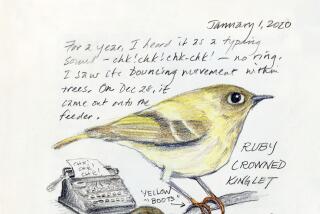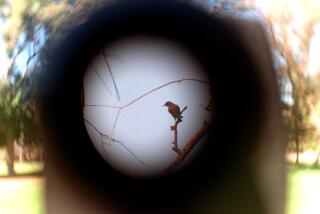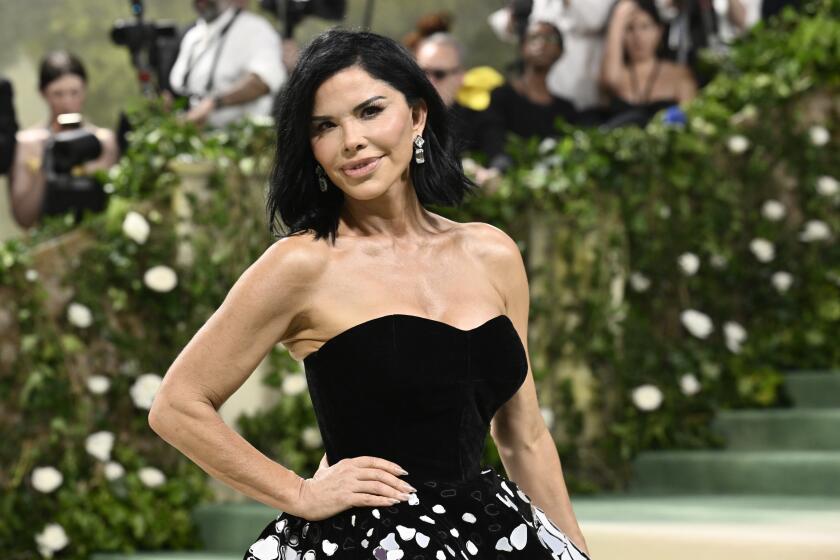Review: Charlie Jane Anders’ ‘All the Birds in the Sky’ has the hallmarks of an instant sci-fi classic
Charlie Jane Anders’ brilliant, cross-genre novel “All the Birds in the Sky” has the hallmarks of an instant classic. It’s a beautifully written, funny, tremendously moving tale that explodes the boundaries between science fiction and fantasy, YA and “mainstream” fiction.
Like the work of other 21st century writers — Kelly Link and Lev Grossman come immediately to mind — “All the Birds in the Sky” serves as both a celebration of and corrective to the standard tropes of genre fiction.
Anders knows genre: She’s the editor of the influential website io9, which celebrates science fiction in film, comics, television and books. Anders, a noted trans activist, has emerged as an author in her own right: She won the Lambda Literary and Edmund White awards for her first book, “Choir Boy,” and her 2011 novelette, “Nine Months, Three Days,” received the Hugo Award.
“All the Birds in the Sky” begins as a somewhat conventional young adult novel. As a child, Patricia Delfine wanders off into the woods, comes across an injured sparrow and learns that she can talk to animals. The sparrow takes her to a tree that resembles Yggdrasil, the World Tree of ancient Norse myth, where she is asked the baffling Endless Question: “Is a tree red?” Before Patricia can answer, her father finds her and locks her in her room for a week. When she emerges, she’s lost the ability to understand the speech of animals: Her memory of the event becomes dreamlike but never completely recedes.
At the same time, a boy named Laurence Armstead is developing his own precocious gifts — he invents a time machine that only propels him forward two seconds. He finds it useful for avoiding bullies and boring dinner table conversations with parents. It also helps Laurence gain entrée to a group of rocket scientists who adopt him as an unofficial mascot.
Patricia and Laurence meet when they’re both sent to the same awful private school. Patricia tells Laurence about her numinous encounter with the tree. Laurence confides that he’s built a super-computer in his bedroom closet. But their efforts to nudge the computer into sentience result in Laurence’s expulsion and Patricia’s transfer to Eltisley Maze, a school for young sorcerers reminiscent of Grossman’s Brakebills College for Magical Pedagogy, itself a grown-up version of Harry Potter’s Hogwarts. Magic does exist, after all!
Join the conversation on Facebook >>
This long opening section, nearly a third of the novel, is charmingly written, if a tad too reliant on the boilerplate YA origin narrative: sensitive, supernaturally gifted misfits versus mean people. The story shifts radically when it picks up some years later and becomes a much darker — and funnier — novel about genuine young adults, Laurence and Patricia, now in their 20s and living in San Francisco.
Huge swaths of the country have been rendered uninhabitable by climate change and raging epidemics of disease and starvation. Patricia has become a magical renegade, using her powers of healing to help the injured and displaced, actions proscribed by her former instructors at Eltisley Maze. Laurence is now part of the Ten Percent Project, funded by a billionaire whose dream is to send 10% of Earth’s population to the stars. As a fellow researcher states, “It’s over. ... We are going to need a new planet.”
Against this grim backdrop, Laurence and Patricia meet and become lovers, in one of the more endearing literary romances of recent years. Because, just like in our own world, life goes on despite seemingly unimaginable horrors. People fall in love, go to work, use social media to find a decent restaurant and crack jokes.
“My biggest fear about the apocalypse isn’t being eaten by cannibals,” a character says wryly. “It’s the fact that in every other postapocalyptic movie you see someone with an acoustic guitar by the campfire.”
Anders’ humor elevates this marvelous book above the morass of dystopian novels that have flooded the literary landscape. So does her ability to portray a realistic yet original vision of the near-future, especially in her depiction of the Caddy, a smartphone-like device that relies on serendipity (and which, one hopes, will soon be available in various colors). The result feels like one of William Gibson‘s baroquely complex worlds, aerated by lighter-than-air dialogue and an engaging, diverse cast of supporting characters you’d love to meet at your next end-of-the-world party.
Like Gibson, Anders weaves a thrilling, seat-of-the-pants narrative with a compelling subtext. Through Laurence and Patricia, she explores the tension between those who would exploit our world’s increasingly limited natural resources to save humanity and those who believe that humanity isn’t just part of the problem, it is the problem. The final showdown between Science and Magic lends to a satisfying cliffhanger ending that feels, despite being a clear setup for a second novel, genuinely earned.
“When the whole world turns chaotic, we must be the better part of chaos,” Patricia’s mentor tells her in a dark moment. It’s a line that feels like a call to arms from two seconds into our own future.
Hand’s 14th novel, “Hard Light,” will be published this spring.
::
All the Birds in the Sky
Charlie Jane Anders
Tor: 320 pp., $25.99
More to Read
Sign up for our Book Club newsletter
Get the latest news, events and more from the Los Angeles Times Book Club, and help us get L.A. reading and talking.
You may occasionally receive promotional content from the Los Angeles Times.









